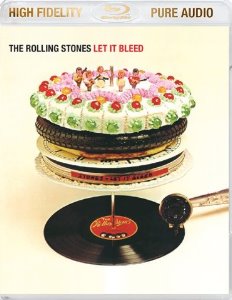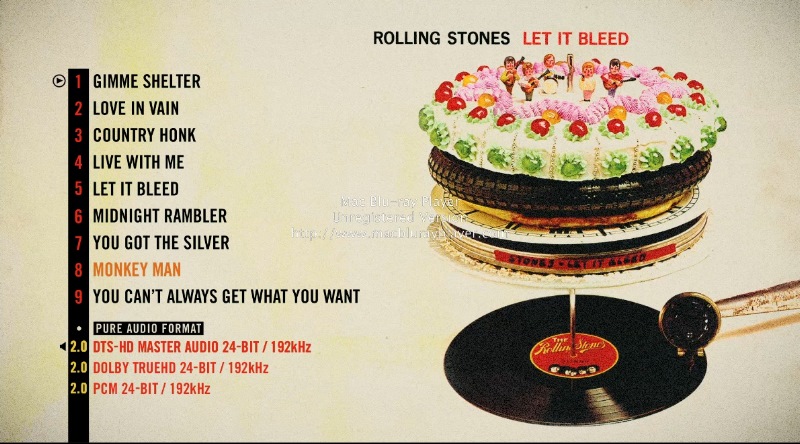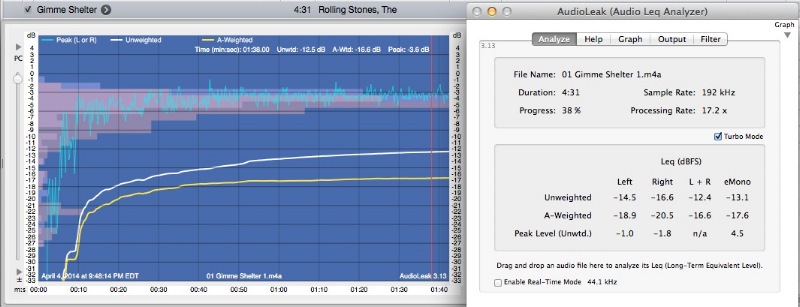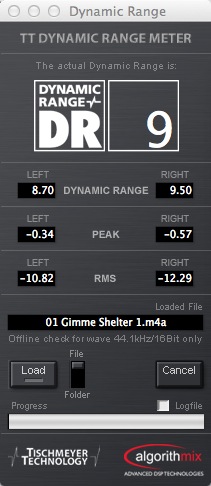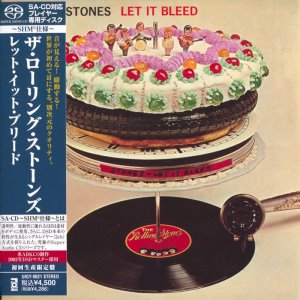|
The
Rolling Stones
- Let It Bleed
[Blu-ray
Audio]
Review by Daniel Lalla
Producer: Universal
Music Group (ABKCO Records)
Disc:
Region: FREE!
(as verified by the
Oppo Blu-ray player)
Total Music time: 0:42:20
Disc Size: 8,959,098,880 bytes
Audio: 2.0 Stereo LPCM or DTS-HD 24 / 192 or Dolby TRUEHD
24/192 (24 bit depth and 192 kHz sampling rate
Chapters: 9 (one per song)
Case: Transparent Blu-ray case
Release date: March 3rd, 2014
Extras:
A
foldout with photos and lyrics and extensive description of
the recording process of the album. A paper with a code to
access the Blu-ray disc digital downloads online
Produced By: Jimmy Miller
The Rolling Stones - Let It Bleed Track Listing:
1. Gimme Shelter (4:31)
2. Love In Vain (4:21)
3. Country Honk (3:06)
4. Live With Me (3:33)
5. Let It Bleed (5:28)
6. Midnight Rambler (6:51)
7. You Got The Silver (2:51)
8. Monkey Man (4:12)
9. You Can't Always Get What You Want (7:25)
Comparison material:
There are essentially 3 options for an album this important
1. The
Blu-ray
audio at 24/192 audio Universal 018771812425
2.
Japanese SHM-SACD UIGY-9021 featuring the DSD remaster
in DSD format
(The 2002 ABKCO SACD with DSD remastering is long out of
print)
3. There is a HDTracks version as well at a 24/176 quality
RIAA Sales: Double platinum in the USA
Singles: “You Can’t Always Get What You Want” charted
at # 42 in 1973
“The three verses (along with the varied theme in the fourth
verse) address the major
topics of the 1960s: love, politics, and drugs.” – from
Wikipedia. I agree.
Awards: # 32 on Rolling Stone magazines top 500 album list
# 24 VH1 greatest album list
# 27 The Guardian greatest album list
#28 Q Magazine’s all time best British albums
Charting: UK number 1, displacing Abbey Road ! Charted for
29 weeks
USA Billboard number 3. Charted for 44 weeks.
Interesting trivia : There is just too much to talk about
with this classic album.
• The day after its release was the famous Altamont incident
captured in “Gimme Shelter” available through the Criterion
Collection. That event was widely seen as the end of the
sixties, in many ways.
• “Gimme Shelter” was the Stones’ response to the political
unrest of the sixties and backlash to the Vietnam war.
Richards wrote the song and from his memoir Life: "I wrote 'Gimmi
Shelter' on a stormy day, sitting in Robert Fraser's
apartment in Mount Street. Anita (Pallenberg) was shooting
Performance at the time, not far away... It was just a
terrible f--king day and it was storming out there. I was
sitting there in Mount Street and there was this incredible
storm over London, so I got into that mode, just looking out
of Robert's window and looking at all these people with
their umbrellas being blown out of their grasp and running
like hell. And the idea came to me... My thought was storms
on other people's minds, not mine. It just happened to hit
the moment."
• This is the first Stones album to be named after one of
the tracks on the album
• This is the last Stones album to feature Brian Jones on
two tracks. He died July 1969.
• The inner sleeve features the lines “THIS RECORD SHOULD BE
PLAYED LOUD” and “HARD KNOX AND DURTY SOX”
• The cover artwork was inspired by the album’s working
title “Automatic Changer” and is a surrealist sculpture by
artist Robert Brownjohn. The rear shot shows the back of the
same piece in shambles. The future queen of British TV
cookery shows, Delia Smith, baked the cake on the front
cover.
• The album was released on LP, reel-to-reel and 8-Track
cassette
• The album is regarded as the Stones at their best in the
1968 to 1972 era, with “Beggars’ Banquet” just prior, and
was followed by “Sticky Fingers” and “Exile on Main Street”
• “Love In Vain” was written by King of the Delta Blues
legend Robert Johnson and features some of the most
bittersweet guitar sliding ever, mimicking the Doppler
effect sound of a train at the station pulling away. Ry
Cooder played the mandolin on the track.
• "Country Honk" is a Hank Williams-style country version of
"Honky Tonk Women", which was released 5 months earlier, the
day after Brian Jones’ death, as a single. “You Can’t Always
Get What You Want” was the B-side. The original version
features dual-citizen and sometimes-Quebecer Nanette Workman
(credited as Nanette Newman)
• This was the last Stones’ album to receive an official
mono release, rare and valuable now.
• From Songfacts (unconfirmed): Keith Richards' fingers
began to bleed as he played acoustic guitar for hours while
Mick Jagger worked with an engineer on the drum track. The
title came from Keith's desire to record his track. At least
that's the story the band tells. Here's an alternate
meaning: The phrase "Let It Bleed" is intravenous drug user
slang for successfully finding a vein. The syringe plunger
is pulled back and if blood appears, is called letting it
bleed.
• The sentence ''and there will always be a space in my
parking lot'' was about Marianne Faithful, Jagger's
girlfriend, who used the euphemism ''parking lot'' to talk
about her private parts.
Audio: I’m going to
get a little technical here, as this is a great case to
discuss the two major competing digital formats: PCM or DSD
technology
The Blu-ray audio disc has one
unusual feature. It’s the inexplicable fact that they used
24/192 for this release. Why? The Stones’ catalogue was
remastered in 2002 using DSD technology and SACDs were
released for the classic era albums and the related hits
compilations. Fortunately, they did not stop there and all
the 70s and 80s era albums were released in Japan on
SHM-SACDs at much greater price. The
SHM-SACD discs are DSD
only releases, with better quality optical material, and
using green label sides without any artwork on them for pure
and improved reflective qualities.
Standard digital recordings can be thought of as plotting
the signal on a graph paper, with the y axis represented by
24 bits in this case, and a value plotted every 1/192000th
of a second (at 192 kHz) on the Y axis.
So explaining DSD is a little weird. It’s a one bit sampling
technology. So think of it as a single bit, on or off,
telling the system if the next little chunk of the audio is
louder or quieter. So how can that possibly work? The answer
is that you sample in the MEGA-hertz range (2.8224 MHz), at
much, much higher resolution than audible audio. So you
recreate the waveform with a ‘moving’ bit, i.e. moving up or
down. You have 64 times as many samples as you would in a
44.1 KHz CD for example. So your wave can move up or down,
in theory, in 64 steps for every 1 sample on a CD. The sound
engineering and math people estimate that the effective bit
depth is about 20-23 bits, but many say the reproduction of
the waveform is more accurate and more ‘analog-like’
So it is quite clear that if a recording was made digitally
using PCM, it should REMAIN that way. There is nothing to be
gained and only potentially information to be lost by
converting it to DSD. Those albums would, in theory, be best
released on a PCM format like
Blu-ray audio, or DVD-Audio, or
a PCM HDTracks download. If the original album master is
analog, then it is a choice: PCM or DSD? Audiophiles have
been arguing endlessly about this, with some talking about
‘tired old SACD’ (which I find laughable) or arguing the
benefits or 96 versus 192 sampling rates in the PCM domain.
My contention is that the 24 bit depth is a marked
improvement over 16 bit CD technology. It results in a much
greater signal-to-noise ratio and gives extra headroom over
CDs for an uncompressed release, yet still being full of
detail. My personal preference is that in the case of
analogue masters, DSD has generally won out, but it is clear
that the choices made during mastering are really what is
MOST important. You can use a lousy master or massively
punch up the audio (brickwalling practice) to make it sound
louder. Audiophile releases are not immune from this.
On the HDTracks release, the used 24/176.4 release for “Let
It Bleed”. Why does this make sense? Because it is a
mathematical multiple of 44.1 and so is DSD’s 2.8224 MHz
sampling. So, in theory, this PCM rate makes more sense as
during the conversion you fall on direct common multiples
which should make it easier for DSD to PCM conversion. In
this range and high resolution depth, the question is, does
it even matter?
Fortunately, the
Blu-ray
audio seems to have been wonderfully mastered. The DSD
masters done in 2002 were just simply stunning. The
recordings took on new life with a punch and depth never
heard before. Tight bass and crisp highs and unreal amounts
of detail were opening like restoring a painting. I have the
Virgin Records remasters of Stones albums from the 70s and
80s using Apogee remasters and they were disappointing. The
original CDs suffered from a blandness that should never be
associated with a band this important..
The
Blu-ray,
to my ears, sounds every bit as good as the Japanese
SHM-SACD.
I occasionally think I hear a difference in the DSD, and go
back and re-listen carefully – it’s all there in the
Blu-ray,
as far as I can tell.
Analysis: Someone was nice enough on the internet to have done a
full dynamic range analysis on the
SHM-SACD. It’s mastered right close up to 0 dB and the DR
scores show a lot of variability from 8 to 13, reflecting the differing
styles of music and recording styles in these songs. Although the volume
level on the
Blu-ray
is slightly lower overall, the DR scores are identical. This, and the
fact that they list DSD technician on the information, just cements that
they used the DSD master as the origin for the
Blu-ray.
Analysis of “Gimme Shelter” on both
SHM-SACD and
Blu-ray
shows no compression whatsoever, even on this loudest track on the
album. It’s clear in all the tracks that great care was taken to avoid
the brickwall approach. THIS WAS DONE RIGHT AND THEY ARE CORRECT: “THIS
RECORD SHOULD BE PLAYED LOUD”.
Curve:
Blu-ray
Track one – correctly mastered!
Dynamic range analysis:
Blu-ray
and
SHM-SACD
IThe Stones said “THIS RECORD SHOULD BE PLAYED LOUD”.
I would add: “THIS
Blu-ray
SHOULD BE BOUGHT IMMEDIATELY”
It won’t get better than this and the
SHM-SACD for a digital release. You can get a
sound that is, for all intents and purposes, as good as the
Japanese
SHM-SACD for ½ the price and get a digital
download as well. If you are a purist, you will want the
SHM-SACD since it IS the DSD used for the
remastering in 2002. In theory, it should be the best. It
should also, in theory, be better than vinyl releases based
on that 2002 DSD remaster, unless you like the way vinyl or
your particular cartridge/phonostage setup color the sound.
Yes, I said that. I love vinyl, but if you think about it
logically for a second, if the remaster is digital DSD, how
can the vinyl be better without ‘adding’ something to the
purity of the music?
Music:
5 stars – Not pop but a more pensive, musically smart group
were revealed
Sound:
5 stars – For the era of the recording, and using DSD
remasters, hard to imagine they could have done better
Once the download servers are back on line I’ll report back
and tell you what format the digital download is. If it is
not 24/192 and you use a music server, I would have to then
recommend HDTracks 24/176.4 release, which also comes from
the Stones directly and should sound every ‘bit’ as good.
(no pun intended). But you lose the wonderful artwork of
this classic release.
Summary:
This is an important album. If you want pop songs, look
elsewhere. If you want to see what the Stones were capable
of, this is one of the best places to start.
For the audio quality, it’s too close to call – the
Blu-ray
audio is much cheaper than the
SHM-SACD
|
Format |
Release: |
DR Score Notes |
|
Blu-ray
audio |
10 |
Ranges 8 to 13 |
|
SHM-SACD |
10 |
Ranges 8 to 13 |
Daniel Lalla
April 6th, 2014
|
![]()
![]()

![]()
![]()
![]()
![]()

![]()
![]()












